Coronary heart disease
Heart disease, Coronary heart disease, Coronary artery disease; Arteriosclerotic heart disease; CHD; CAD
Coronary heart disease is a narrowing of the blood vessels that supply blood and oxygen to the heart. Coronary heart disease (CHD) is also called coronary artery disease.

Coronary Artery Disease (CAD) includes diseases of the arteries that supply the heart muscle with blood. It is responsible for more than half of all cardiovascular events in men and women under the age of 75 years. CAD, which is sometimes called coronary heart disease or ischemic heart disease, is most often caused by atherosclerosis. Atherosclerotic plaque forms when cholesterol and other fatty material are deposited within the arterial wall. Plaque deposits narrow the coronary arteries that supply the heart, thereby reducing blood flow to the heart muscle. If plaque ruptures, it can trigger the formation of a blood clot and completely obstructs the flow of blood to the heart. CAD also has many non-atherosclerotic causes, including genetic abnormalities of the coronary vessels, systemic vasculitis, and radiation-induced coronary disease. When coronary arteries are narrowed or blocked, oxygen-rich blood cannot reach the heart muscle, resulting in chest pain, also called angina or myocardial infarction. Over time, CAD may weaken the heart muscle and lead to serious pumping problems and abnormal heart rhythms. Therapeutic approaches for CAD include the use of 3 strategies: First, treatment to reduce the heart’s workload Second, improving coronary artery blood flow Third, slowing down or reversing the build-up of atherosclerotic plaques. The heart’s workload can be reduced by controlling the BP and using drugs such as beta blockers or calcium-channel blockers that keep the heart from pumping as hard. Coronary blood flow can be improved by surgical procedures such as a percutaneous coronary intervention or coronary artery bypass grafting. A coronary artery thrombus may sometimes be dissolved by drugs, also improving coronary circulation. Modifying the diet, exercising regularly, and appropriate pharmacological therapy can slow down or help reverse atherosclerosis.

The interior of the heart is composed of valves, chambers, and associated vessels.

The external structures of the heart include the ventricles, atria, arteries and veins. Arteries carry blood away from the heart while veins carry blood into the heart. The vessels colored blue indicate the transport of blood with relatively low content of oxygen and high content of carbon dioxide. The vessels colored red indicate the transport of blood with relatively high content of oxygen and low content of carbon dioxide.
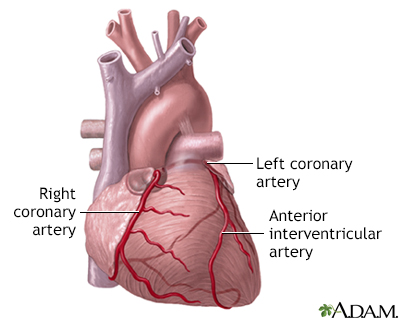
The coronary arteries supply blood to the heart muscle. The right coronary artery supplies both the left and the right heart; the left coronary artery supplies the left heart.
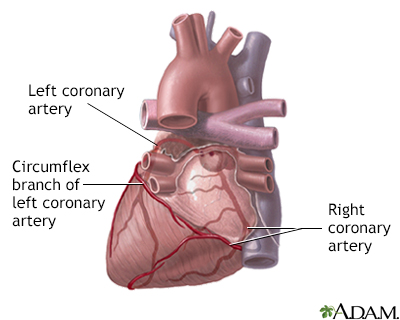
The coronary arteries supply blood to the heart muscle. The right coronary artery supplies both the left and the right heart; the left coronary artery supplies the left heart.

When people have chest pain, they're often concerned they're having a heart attack. I'm Dr. Alan Greene and I'd like to talk to you for a moment about the different kinds of chest pain and when it may be an emergency. It turns out, there are lots of different kinds of chest pain. In fact, almost everything in the chest can hurt in one way or another. Some of the causes are really nothing more than a minor inconvenience. Some of them though are quite serious, even life threatening. You can have chest pain sure from the heart, but also from pneumonia. You can have chest pain from asthma. You can have chest pain from a blood clot in the lungs. It can be from nothing more than a strain of some of the muscles between the ribs, or nerves. You can also have chest pain that comes from acid reflux of from a stomach ulcer, gallstones. Many, many things can cause chest pain. You want to call 911 if you are having sudden, crushing chest pain or if your chest pain radiates into the jaw or the left arm. You want to call 911 if your chest pain also causes shortness of breath, or dizziness, nausea, or vomiting. You want to call 911 if you know you have heart disease and you do occasionally have pain but your pain is getting significantly worse than it is ordinarily. Or comes on with less activity than it does otherwise. But whatever the cause of chest pain, unless you're sure what's causing it, it's worth contacting your physician to find out what may be going on. It's not a symptom to ignore.
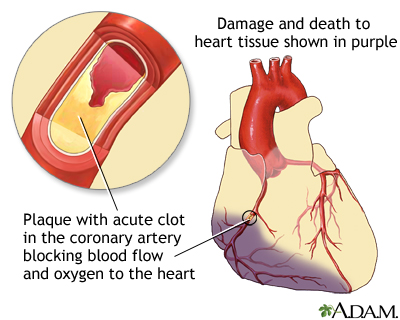
A heart attack or acute myocardial infarction (MI) occurs when one of the arteries that supplies the heart muscle becomes blocked. Blockage may be caused by spasm of the artery or by atherosclerosis with acute clot formation. The blockage results in damaged tissue and a permanent loss of contraction of this portion of the heart muscle.
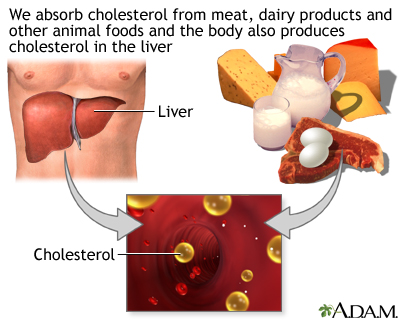
Cholesterol is a waxy, fat-like material that is found in all parts of the body. It comes from two sources: our liver produces it, and we consume it in animal products.

Angina, or angina pectoris, is temporary chest pain or a sensation of pressure that occurs when the heart’s need for oxygen is not satisfied by the amount of blood supplied to the heart. Blood flow can be limited when the arteries are narrowed by atherosclerosis, or because of coronary artery spasms. Symptoms of angina may also include discomfort in the shoulders, inside the arms, through the back and in the throat, jaw, or teeth. Angina due to atherosclerosis usually occurs during physical exertion or emotional distress, or at rest if the artery is narrowed by more than 70%.
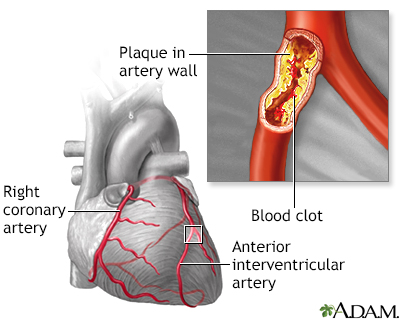
Atherosclerosis is a disease of the arteries in which fatty material is deposited in the vessel wall, resulting in narrowing and eventual impairment of blood flow. Severely restricted blood flow in the arteries to the heart muscle leads to symptoms such as chest pain. Atherosclerosis shows no symptoms until a complication occurs.
Coronary Artery Disease (CAD) includes diseases of the arteries that supply the heart muscle with blood. It is responsible for more than half of all cardiovascular events in men and women under the age of 75 years. CAD, which is sometimes called coronary heart disease or ischemic heart disease, is most often caused by atherosclerosis. Atherosclerotic plaque forms when cholesterol and other fatty material are deposited within the arterial wall. Plaque deposits narrow the coronary arteries that supply the heart, thereby reducing blood flow to the heart muscle. If plaque ruptures, it can trigger the formation of a blood clot and completely obstructs the flow of blood to the heart. CAD also has many non-atherosclerotic causes, including genetic abnormalities of the coronary vessels, systemic vasculitis, and radiation-induced coronary disease. When coronary arteries are narrowed or blocked, oxygen-rich blood cannot reach the heart muscle, resulting in chest pain, also called angina or myocardial infarction. Over time, CAD may weaken the heart muscle and lead to serious pumping problems and abnormal heart rhythms. Therapeutic approaches for CAD include the use of 3 strategies: First, treatment to reduce the heart’s workload Second, improving coronary artery blood flow Third, slowing down or reversing the build-up of atherosclerotic plaques. The heart’s workload can be reduced by controlling the BP and using drugs such as beta blockers or calcium-channel blockers that keep the heart from pumping as hard. Coronary blood flow can be improved by surgical procedures such as a percutaneous coronary intervention or coronary artery bypass grafting. A coronary artery thrombus may sometimes be dissolved by drugs, also improving coronary circulation. Modifying the diet, exercising regularly, and appropriate pharmacological therapy can slow down or help reverse atherosclerosis.
Causes
CHD is the leading cause of death in the United States for men and women.
CHD is caused by the buildup of plaque in the arteries to your heart. This may also be called hardening of the arteries or atherosclerosis.
- Fatty material and other substances form a plaque buildup on the walls of your coronary arteries. The coronary arteries bring blood and oxygen to your heart.
- This buildup causes the arteries to get narrow.
- As a result, blood flow to the heart can slow down or stop.
A risk factor for heart disease is something that increases your chance of getting it. You cannot change some risk factors for heart disease, but you can change others.
Symptoms
In some cases, symptoms may be very noticeable. But, you can have the disease and not have any symptoms. This is more often true in the early stages of CHD.
Chest pain or discomfort (angina) is the most common symptom. You feel this pain when the heart is not getting enough blood or oxygen. The pain may feel different from person to person.
- It may feel heavy or like someone is squeezing your heart. You may feel it under your breast bone (sternum). You may also feel it in your neck, arms, stomach, or upper back.
- The pain most often occurs with activity or emotion. It goes away with rest or a medicine called nitroglycerin.
- Other symptoms include shortness of breath and fatigue with activity (exertion).
Some people have symptoms other than chest pain, such as:
- Fatigue
- Shortness of breath
- General weakness
Learn about the symptoms and causes of angina pectoris.
When people have chest pain, they're often concerned they're having a heart attack. I'm Dr. Alan Greene and I'd like to talk to you for a moment about the different kinds of chest pain and when it may be an emergency. It turns out, there are lots of different kinds of chest pain. In fact, almost everything in the chest can hurt in one way or another. Some of the causes are really nothing more than a minor inconvenience. Some of them though are quite serious, even life threatening. You can have chest pain sure from the heart, but also from pneumonia. You can have chest pain from asthma. You can have chest pain from a blood clot in the lungs. It can be from nothing more than a strain of some of the muscles between the ribs, or nerves. You can also have chest pain that comes from acid reflux of from a stomach ulcer, gallstones. Many, many things can cause chest pain. You want to call 911 if you are having sudden, crushing chest pain or if your chest pain radiates into the jaw or the left arm. You want to call 911 if your chest pain also causes shortness of breath, or dizziness, nausea, or vomiting. You want to call 911 if you know you have heart disease and you do occasionally have pain but your pain is getting significantly worse than it is ordinarily. Or comes on with less activity than it does otherwise. But whatever the cause of chest pain, unless you're sure what causing it, it's worth contacting your physician to find out what may be going on. It's not a symptom to ignore.
Exams and Tests
Your health care provider will examine you. You will often need one or more tests before getting a diagnosis.
Tests to evaluate for CHD may include:
- Coronary angiography -- an invasive test that evaluates the heart arteries under x-ray.
- Echocardiogram stress test.
- Electrocardiogram (ECG).
- Electron-beam computed tomography (EBCT) to look for calcium in the lining of the arteries. The more calcium, the higher your chance for CHD.
- Exercise stress test.
- Heart CT scan.
- Nuclear stress test.
Treatment
You may be asked to take one or more medicines to treat blood pressure, diabetes, or high cholesterol levels. Follow your provider's directions closely to help prevent CHD from getting worse.
Goals for treating these conditions in people who have CHD:
- The most commonly used blood pressure target for people with heart disease is less than 130/80, but your provider may recommend a different blood pressure target.
- If you have diabetes, your HbA1c levels will be monitored and brought down to the level your provider recommends.
- Your LDL cholesterol level will be lowered with statin or other medicines.
Treatment depends on your symptoms and how severe the disease is. You should know about:
- Other medicines used to treat angina.
- What to do when you have chest pain.
- Being active when you have heart disease.
- Eating a heart-healthy diet.
Never stop taking your medicines without first talking to your provider. Stopping heart medicines suddenly can make your angina worse or cause a heart attack.
You may be referred to a cardiac rehabilitation program to help improve your heart's fitness.
Procedures and surgeries used to treat CHD include:
- Angioplasty and stent placement, called percutaneous coronary interventions (PCIs)
- Coronary artery bypass surgery
- Minimally invasive heart surgery
Outlook (Prognosis)
Everyone recovers differently. Some people can stay healthy by changing their diet, stopping smoking, and taking their medicines as prescribed. Others may need medical procedures such as angioplasty or surgery.
In general, early detection of CHD generally leads to a better outcome.
When to Contact a Medical Professional
If you have any risk factors for CHD, talk to your provider about prevention and possible treatment steps.
Call your provider, call the local emergency number (such as 911), or go to the emergency room right away if you have:
- Angina or chest pain
- Shortness of breath
- Symptoms of a heart attack
Prevention
Take these steps to help prevent heart disease.
- If you smoke or use tobacco, stop. There are many resources available to help you stop smoking and tobacco use.
- Learn how to eat a heart-healthy diet by making simple substitutions. For example, choose heart-healthy fats over butter and other saturated fats.
- Get regular exercise, ideally at least 30 minutes five days per week. If you have heart disease, talk with your provider about starting an exercise routine.
- Maintain a healthy body weight.
- Lower high cholesterol with lifestyle changes, and if needed, statin or other medicines.
- Lower high blood pressure using diet and medicines.
- Talk with your provider about aspirin therapy.
- If you have diabetes, keep it well-managed to help prevent heart attack and stroke.
Even if you already have heart disease, taking these steps will help protect your heart and prevent further damage.
References
Arnett DK, Blumenthal RS, Albert MA, et al. 2019 ACC/AHA Guideline on the primary prevention of cardiovascular disease: a report of the American College of Cardiology/American Heart Association Task Force on Clinical Practice Guidelines. [published correction appears in Circulation. 2019;140(11):e649-e650] [published correction appears in Circulation. 2020;141(4):e60] [published correction appears in Circulation. 2020;141(16):e774]. Circulation. 2019 2019;140(11):e596-e646. PMID: 30879355
Boden WE. Angina pectoris and stable ischemic heart disease. In: Goldman L, Cooney KA, eds. Goldman-Cecil Medicine. 27th ed. Philadelphia, PA: Elsevier; 2024:chap 56.
Marks AR. Cardiac and circulatory function. In: Goldman L, Cooney KA, eds. Goldman-Cecil Medicine. 27th ed. Philadelphia, PA: Elsevier; 2024:chap 41.
Morrow DA, de Lemos J. Stable ischemic heart disease. In: Libby P, Bonow RO, Mann DL, Tomaselli GF, Bhatt DL, Solomon SD, eds. Braunwald's Heart Disease: A Textbook of Cardiovascular Medicine. 12th ed. Philadelphia, PA: Elsevier; 2022:chap 40.
Virani SS, Newby LK, Arnold SV, et al. 2023 AHA/ACC/ACCP/ASPC/NLA/PCNA Guideline for the management of patients with chronic coronary disease: A report of the American Heart Association/American College of Cardiology joint committee on clinical practice guidelines. Circulation. 2023;148:e9–e119.
Whelton PK, Carey RM, Aronow WS, et al. 2017 ACC/AHA/AAPA/ABC/ACPM/AGS/APhA/ASH/ASPC/NMA/PCNA guideline for the prevention, detection, evaluation, and management of high blood pressure in adults: a report of the American College of Cardiology/American Heart Association Task Force on Clinical Practice Guidelines. Hypertension. 2018;72(3):e33. PMID: 29133354
Version Info
Last reviewed on: 2/23/2022
Reviewed by: Thomas S. Metkus, MD, Assistant Professor of Medicine and Surgery, Johns Hopkins University School of Medicine, Baltimore, MD. Internal review and update on 02/19/2024 by David C. Dugdale, MD, Medical Director, Brenda Conaway, Editorial Director, and the A.D.A.M. Editorial team.
